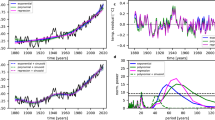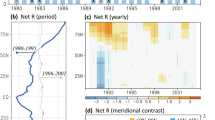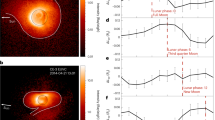Abstract
A STATISTICALLY significant correlation has been found between the derivatives of the envelopes of peak tidal stresses at high northern latitudes and the mean temperature of the Northern Hemisphere as reflected in oxygen isotope ratios in the Greenland ice cap. We suggest that variations in tidal stresses on the Earth caused by the Sun and Moon cause changes in the amount of stratospheric dust produced by volcanic activity; this in turn changes the thickness of the stratospheric dust veil and hence the atmospheric radiation balance. We find that, for a simple model, periodic variations in tidal stress account for 13% of the variance in the ice-core temperature record.
This is a preview of subscription content, access via your institution
Access options
Subscribe to this journal
Receive 51 print issues and online access
$199.00 per year
only $3.90 per issue
Buy this article
- Purchase on Springer Link
- Instant access to full article PDF
Prices may be subject to local taxes which are calculated during checkout
Similar content being viewed by others
References
The Eruption of Krakatoa, and Subsequent Phenomena (edit. by G. J. Symons), 405 (Harrison and Sons, London, 1888).
Lamb, H. H., Phil Trans. R. Soc., A 266, 425 (1970).
SMIC, Inadvertent Climate Modification, 308 (MIT Press, Cambridge, Massachusetts and London, 1971).
Abbot, C. G., and Fowle, F. E., Smithson misc. Collns, 60, 29; Ann. astrophys. Obs. Smithson. Inst., 3, 211 (1913).
Hamilton, W. L., J. geophys. Res., 78, 3363 (1973).
Melchior, P., The Earth Tides, 458 (Pergamon, Oxford, 1966).
Johnston, M. J. S., and Mauk, F. J., Nature, 239, 266 (1972).
Rinehart, J. S., Science, 177, 346 (1972).
National Geographic Society, Atlas of the World, 190 (1975).
Dansgaard, W., Johnsen, S. J., Clausen, H. B., and Langway, L. A., in Late Cenezoic Glacial Ages (edit. by Turekian, K. K.) (Yale University Press, 1971); see also Nature, 227, 482 (1971).
Suess, H. E., Meteorol. Monogr., 8, 146 (1968).
Junge, C., in Proc. Int. Conf. on Structure, Composition and General Circulation of the Upper and Lower Atmospheres and Possible Anthropogenic Perturbations, 1, 85 (1974).
Shaw, H. R., Kistler, R. W., and Evernden, J. F., Geol. Soc. Am. Bull., 82, 869 (1971).
Heaton, T. H., Geophys. J. R. astr. Soc., 43, 307 (1975).
Tokarev, P. I., Bull. Vulcan., 35, 243 (1971).
King, J. W., Astronaut. Aeronaut., 13, 10 (1975).
Bray, J. R., Nature, 228, 42 (1974).
Cohen, T. J., and Lintz, P. R., Nature, 250, 398 (1974).
Author information
Authors and Affiliations
Rights and permissions
About this article
Cite this article
ROOSEN, R., HARRINGTON, R., GILES, J. et al. Earth tides, volcanos and climatic change. Nature 261, 680–682 (1976). https://doi.org/10.1038/261680a0
Received:
Accepted:
Published:
Issue Date:
DOI: https://doi.org/10.1038/261680a0
This article is cited by
-
Holocene palaeo-wind evidence from palynology in Baffin Island
Nature (1978)
-
Climate periods in tree, ice and tides
Nature (1977)
-
Volcanic dust veils and North Atlantic climatic change
Nature (1977)
-
Gibt es Klimaschwankungen?
Naturwissenschaften (1977)
Comments
By submitting a comment you agree to abide by our Terms and Community Guidelines. If you find something abusive or that does not comply with our terms or guidelines please flag it as inappropriate.



